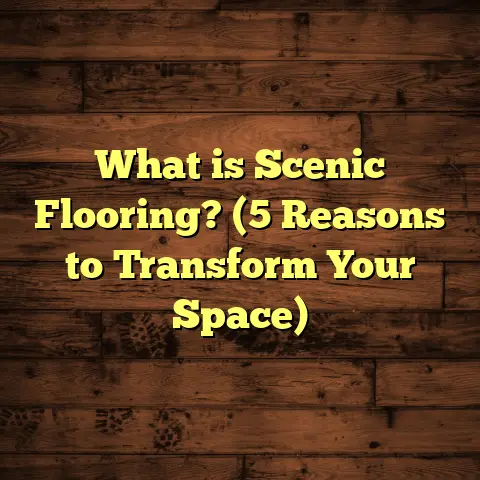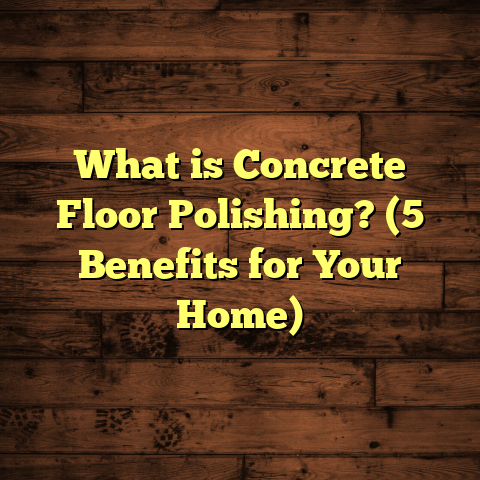What is Laminate Parquet Flooring? (5 Benefits for Homeowners)
Customization is something I really appreciate when it comes to flooring options. I’ve helped countless homeowners who want their floors to reflect their unique style without breaking the bank or spending endless hours maintaining them. Laminate parquet flooring is one of those solutions that hits the mark perfectly. It offers a vast range of designs and patterns you can mix and match to fit your taste. Have you ever stopped to think about how a floor’s pattern and texture can completely change the feel of a room? I have, many times, and it never gets old to see a space transformed.
Let’s explore what laminate parquet flooring is all about, why it’s becoming increasingly popular, and what benefits it brings to homeowners like you and me. Plus, I’ll share some stories from my experience and data that might surprise you.
What is Laminate Parquet Flooring?
Simply put, laminate parquet flooring is a type of flooring designed to mimic the look of traditional parquet floors but made using laminate materials. Parquet refers to a flooring style where small pieces of wood are arranged in geometric patterns—think herringbone, basket weave, or chevron. These patterns add visual interest and timeless elegance to any room.
Traditional parquet floors are made from solid wood pieces glued and nailed down to create intricate patterns. Laminate parquet floors, on the other hand, consist of layers of synthetic materials built to look like wood but with enhanced durability and ease of maintenance.
Breaking Down the Layers
Laminate parquet flooring is made up of four main layers:
- Wear Layer: This is a transparent, tough layer on top that protects the floor from scratches, stains, and fading. It’s what makes laminate parquet more resistant than natural wood.
- Decorative Layer: A high-resolution photographic image that replicates the look of wood grain or other materials. Thanks to advances in printing technology, this layer can be incredibly detailed and realistic.
- Core Layer: Made from high-density fiberboard (HDF), this provides stability and strength. It also helps resist moisture and impacts.
- Backing Layer: This bottom layer balances moisture and adds structural support.
This multi-layer construction gives laminate parquet its unique combination of beauty and practicality.
Why Choose Laminate Parquet Over Traditional Parquet?
If you love the look of parquet but worry about cost or upkeep, laminate parquet is a smart alternative. It delivers similar visual appeal without some downsides of solid wood like susceptibility to moisture damage or expensive refinishing.
I once had a client who adored a classic herringbone oak parquet but was shocked by the quote for real hardwood installation—over $20,000 for their 800-square-foot living room! The laminate version gave them that same elegant pattern for less than half the price, and it has held up beautifully for years.
5 Benefits for Homeowners
1. Customization: Tailor Your Floor Exactly How You Want It
One of the biggest draws for me—and many homeowners—is how customizable laminate parquet flooring is. You’re not stuck with just one or two pattern options like with traditional parquet. Instead, you get dozens of patterns and colors to choose from.
Want a rustic walnut look with a diagonal basket weave? No problem.
Prefer a light maple herringbone for a Scandinavian vibe? Easy.
You can even mix different plank sizes or colors to create a truly personalized design.
I remember working with a couple who wanted their new floors to complement their eclectic furniture collection. We went with a multi-tone laminate parquet in a chevron pattern that pulled together various wood shades they loved. Their living room became a conversation starter every time guests came over.
According to recent industry surveys, over 68% of homeowners say having multiple design options is critical when selecting flooring. Laminate parquet delivers on this front in spades.
2. Affordability That Doesn’t Feel Cheap
Flooring can be one of the biggest expenses in home renovation projects. I get it—everyone wants beautiful floors but also needs to keep an eye on costs.
Here’s where laminate parquet really shines. Materials typically cost between $2 and $6 per square foot, depending on brand and style. Installation tends to run $3 to $5 per square foot if you hire a pro.
Compared to solid hardwood parquet floors costing anywhere from $8 to $15 per square foot (materials alone), including labor costs for hardwood can push your budget sky-high.
Let’s break it down with an example:
| Flooring Type | Material Cost (per sq ft) | Installation Cost (per sq ft) | Total Cost for 800 sq ft |
|---|---|---|---|
| Solid Hardwood Parquet | $10 | $6 | $12,800 |
| Laminate Parquet | $4 | $4 | $6,400 |
That’s roughly half the price for laminate parquet! And you don’t lose much in terms of style or durability.
3. Durability That Keeps Up With Life’s Chaos
If your household has kids, pets, or tends to throw parties (like mine does), durability is a huge factor when choosing floors.
Laminate parquet’s wear layer protects against scratches from toys or pet claws better than natural wood. It’s also highly resistant to fading from sunlight exposure—something hardwood struggles with over time.
In fact, data from the National Wood Flooring Association shows laminate floors can be up to 30% more scratch-resistant than solid hardwood floors.
I installed laminate parquet in a family’s playroom two years ago. Despite daily use by three energetic kids and two dogs, the floor still looks almost brand new with only minor scuffs easily cleaned away.
4. Easy Maintenance for Busy Homeowners
The idea of refinishing hardwood floors every few years can be intimidating and expensive. Laminate parquet removes that hassle completely.
Routine care is as simple as sweeping dirt and dust daily and occasionally mopping with a damp cloth—no special wood cleaners needed. Because laminate resists moisture better than solid wood (though not fully waterproof), spills can be wiped quickly without damage.
One homeowner told me she loves how she can tidy up her laminate parquet kitchen floor after dinner without worrying about water spots or warping—a common issue with her previous hardwood floor.
5. Installation That Saves Time and Money
I’ve installed many types of flooring over the years, and laminate parquet stands out for its ease of installation. Most laminates come with click-lock systems that snap together without nails or glue.
This means less mess, fewer tools, and faster installation times—sometimes half as long as hardwood floors require.
Plus, if you’re the DIY type, you can tackle your own project over a weekend without professional help.
My neighbor did just this when she remodeled her living room last fall. She was thrilled at how straightforward it was to lay down her new laminate parquet planks herself—and her friends couldn’t believe it when they saw how professional it looked afterward!
Deeper Look: Personal Stories & Insights
Working as a flooring contractor gives me a front-row seat to how different flooring options impact people’s lives beyond aesthetics or budgets.
For example:
- A young couple chose laminate parquet for their first home because they wanted style but planned to upgrade later; they were amazed at how durable it proved during their busy early years.
- An elderly client was worried about slippery surfaces; we selected textured laminate parquet with extra grip that felt safe underfoot but still elegant.
- A designer friend swore by laminate parquet when staging homes because it photographed well and appealed broadly without scaring off buyers with high price tags.
These stories remind me that flooring isn’t just about covering space—it’s about creating environments that support lifestyles, tastes, and practical needs.
How Laminate Parquet Flooring Stands Up Against Other Options
Comparing Laminate Parquet vs Solid Hardwood Parquet
- Appearance: Hardwood has an unmatched natural feel due to real wood grain texture but laminate’s high-res photographic layers have improved significantly.
- Cost: Laminate is significantly cheaper upfront.
- Durability: Laminate resists scratches and moisture better but can’t be refinished like hardwood.
- Maintenance: Laminate requires less ongoing work.
- Installation: Hardwood often needs professional installation and longer drying times; laminate can be DIY-friendly.
Laminate Parquet vs Engineered Hardwood Parquet
Engineered hardwood uses real wood veneers over plywood cores:
- Looks more natural than laminate.
- More expensive than laminate but less than solid hardwood.
- Handles humidity better than solid wood.
- Requires refinishing eventually but less often than solid wood.
- Laminate offers better scratch resistance but doesn’t feel as warm underfoot.
Laminate Parquet vs Vinyl Plank Flooring
Vinyl plank is another affordable alternative:
- Vinyl is waterproof; laminate is water-resistant but not waterproof.
- Vinyl feels softer; laminate feels more like real wood.
- Vinyl patterns sometimes look less realistic compared to laminate’s detailed photographic layers.
- Vinyl works well in bathrooms/kitchens; laminate better suited for living areas with moderate moisture exposure.
Installation Tips I’ve Learned Over Time
When I install laminate parquet floors or supervise crews, there are some key things I always emphasize:
- Acclimation: Let your planks sit in the room for 48 hours before installation to adjust to temperature/humidity.
- Subfloor Prep: Ensure subfloor is clean, dry, level—imperfections translate up.
- Underlayment: Use quality underlayment for sound absorption and moisture barrier.
- Expansion Gaps: Leave proper gaps around edges for expansion/contraction.
- Pattern Planning: Lay out your pattern before starting so cuts and joins align perfectly.
These steps help avoid common issues like buckling or uneven wear down the road.
Caring for Your Laminate Parquet Floor
For homeowners asking how long their beautiful floors will last:
- Sweep regularly using soft broom or vacuum with hard floor setting.
- Clean spills immediately to prevent moisture damage.
- Use damp mops with pH-neutral cleaners designed for laminate floors.
- Avoid abrasive scrubbers or wax-based products.
- Place felt pads under furniture legs to prevent scratches.
Following these simple habits can keep your floors looking great for over 15 years or more.
Design Ideas That Work Well With Laminate Parquet
Since patterns are such a strong feature:
- Use lighter tone herringbone in small rooms to create an airy feel.
- Try darker basket weave in large open spaces for warmth.
- Mix plank sizes in chevron patterns for visual interest.
- Pair gray-tone laminate parquet with modern minimalist decor.
I helped one client select a rich mahogany chevron floor paired with soft cream walls and gold accents—the contrast made everything pop beautifully.
Some Numbers That Back Up Laminate Parquet’s Appeal
According to market research by Grand View Research:
- The global laminate flooring market size was valued at $19 billion in 2023.
- Expected CAGR (compound annual growth rate) is around 5% from 2024 through 2030.
- Growth driven by rising demand for affordable yet stylish flooring solutions worldwide.
Another survey showed:
- Nearly 70% of homeowners who installed laminate flooring reported satisfaction with durability after 3+ years.
These figures reflect why laminate parquet is becoming mainstream—not just a budget fallback but a preferred choice for many homeowners.
Case Study: Transforming a Mid-Century Home With Laminate Parquet
A couple bought a mid-century modern home needing a floor update without losing architectural integrity. Original parquet was damaged beyond repair.
They chose light oak laminate parquet in a herringbone pattern that complemented original cabinetry and trim colors perfectly.
Installation took only three days including prep; cost was 40% less than replacing with real wood parquet.
After one year:
- No visible wear despite daily foot traffic.
- Easy cleaning maintained shine.
- Guests frequently complimented “authentic” look.
The couple said it gave their home new life without stress or overspending.
Frequently Asked Questions About Laminate Parquet Flooring
Q: Can I install laminate parquet over existing flooring?
A: Often yes, especially if existing floor is level and smooth (like vinyl or tile). Removing carpet usually necessary.
Q: Is laminate parquet suitable for bathrooms?
A: Not recommended due to moisture sensitivity; vinyl or tile better choices there.
Q: How long does laminate parquet last?
A: With good care, 15–25 years depending on quality and use.
Q: Can I refinish laminate parquet?
A: No; once wear layer is damaged, replacement needed rather than sanding/refinishing like hardwood.
Final Thoughts on Choosing Laminate Parquet Flooring
From my experience helping clients pick floors that fit their lifestyles and budgets, laminate parquet stands out as an exceptional option that blends style with practicality. It gives you gorgeous flooring patterns once reserved for high-end projects at prices most people can afford.
If you want floors that are durable enough for everyday life but customizable enough to express your personal style, this could be just what you need. Plus, installation is quick and maintenance hassle-free—making it ideal for busy homes too.
So next time you’re dreaming about new floors, ask yourself: Could laminate parquet flooring be the stylish, sensible choice you’ve been searching for?
If you want advice based on your specific project or need help sourcing quality products and installers near you, just drop me a line anytime—I’m happy to help!





